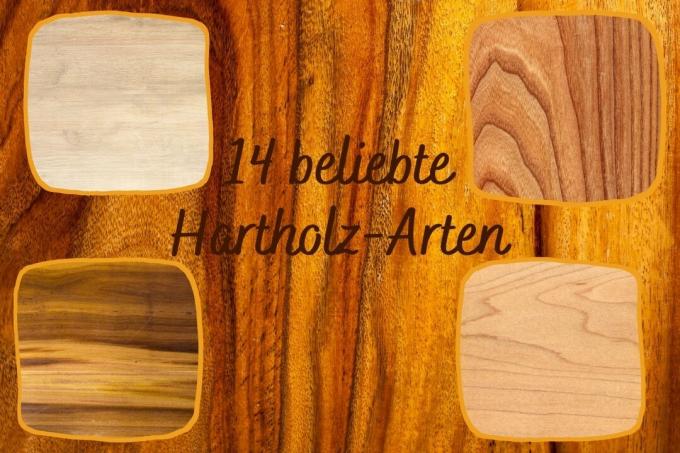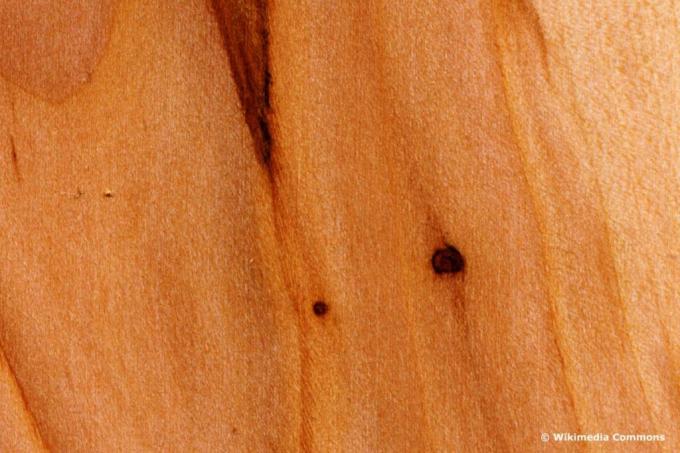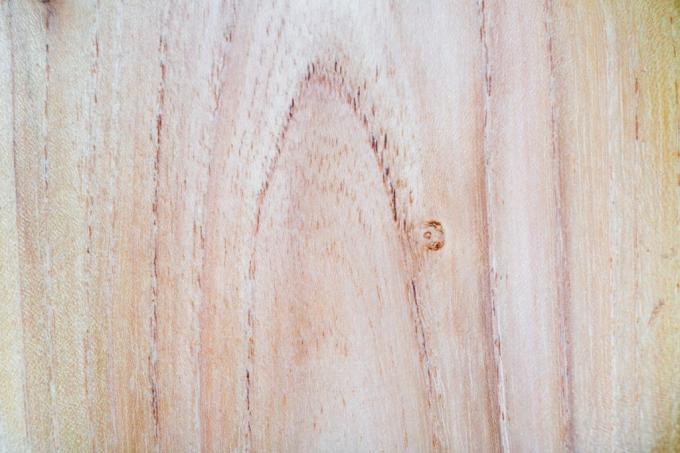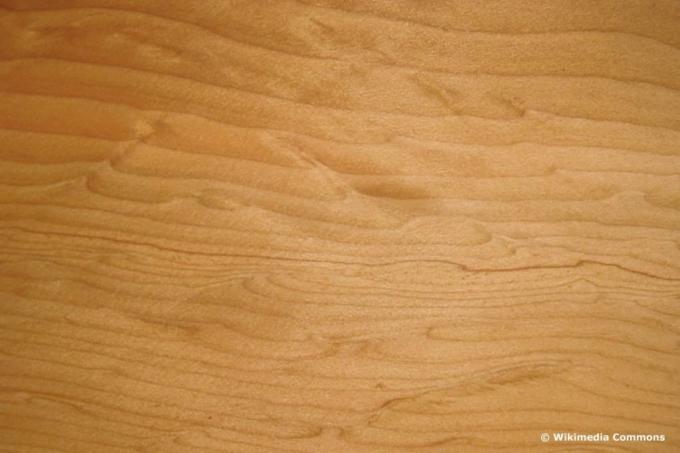
table of contents
- Overview of hardwood
- Wood from A - C
- Woods from D - F
- Woods from G - M
- Wood from N - T
- frequently asked Questions
The natural product wood is always unique. Due to its hardness and resistance, a distinction is made between hardwood and softwood, with hardwood being very popular due to its diverse uses.
In a nutshell
- By means of kiln density, there is a division into hard or soft wood
- Robinia wood is valuable and robust
- Teak is a pure import wood
- The sweet chestnut has a very noble wood
- Hardwoods mainly from deciduous trees
Overview of hardwood
Hardwoods mainly come from deciduous trees. The distinction between softwood and hardwood is made on the basis of the existing kiln density. This stands for the average density of completely dry wood. The wood moisture is 0 percent. It is given in g / cm³. If this figure is above 0.55 g / cm³, then it is hardwood. Everything underneath stands for softwood.
Wood from A - C
Maple (acer)

Occurrence:
- North America
- Europe
- Asia
Particularities:
- very robust and weatherproof
- light yellow to white sapwood
- Core light red-brownish to golden brown
- darkens when exposed to sunlight
- fine pores and wavy texture
- smooth, gray-brown bark
- Dairy density 0.72 g / cm³
Mission:
- Floors and stairs
- furniture
- Musical instruments
Pear tree (pyrus communis)

Origin:
- Central and Southern Europe
- West asia
- Siberia
Particularities:
- very hard and not very elastic
- dries slowly
- yellowish to reddish brown sapwood
- Core color just like sapwood
- darkens when exposed to sunlight
- hardly visible annual rings
- numerous rays
- Pores only visible in cross section
- Density 0.74 g / cm³
- gray-brown, cracked bark
Mission:
- Works of art
- sculpture
- Musical instruments
- Furniture making
- Interior work
Note: There is great demand for pear wood in Europe. It's hard to come by and therefore relatively expensive.
Beech (Fagus sylvatica)

Occurrence:
- Europe
- Mediterranean area
- North Africa and Middle East
Specialty:
- light yellow to reddish-gray sapwood
- similar core color
- slightly flared, striped and fine-cracked texture
- Dose density 0.68 g / cm³
- smooth, gray-green bark
- silver-gray with age
Use:
- Furniture making
- doors and windows
- Floors and stairs
- also as peeling and industrial wood
Woods from D - F
Sweet chestnut (Castanea sativa)

Origin:
- Mediterranean area
- Asia Minor
- North africa
- Caucasus regions
Particularities:
- very fine hardwood
- white sapwood
- Core yellow to dark brown
- fluffy, striped texture
- sometimes also flamed or locked
- Dose density 0.65g / cm³
- deep gray, smooth bark
- colored brown-gray to dark brown in old age
Use:
- Furniture making
- Lumber for indoor and outdoor use
- Wall and ceiling coverings
- Floors and parquet
Oak (Quercus)

Occurrence:
- Europe
- North America
Specialty:
- very hard, yet elastic
- permanently weatherproof
- yellow-white sapwood
- Core brownish-yellow
- Annual rings clearly visible
- thus uniform grain
- Coarse-pored texture, slightly flattened, wood rays
- Dairy density 0.71 g / cm³
- furrowed, gray to gray-green bark
Use:
- Interior work
- Outdoor wooden structures
- Furniture making
- Floors and parquet
Note: The wet wood of oak can quickly corrode metal.
Ash (Fraxinus excelsior)

Occurrence:
- Europe
- Middle east
- North America
Specialty:
- hard and elastic at the same time
- permanently weatherproof
- white to yellowish sapwood
- discoloration reddish to brownish with increasing age
- Core light yellow
- coarse pores
- Annual rings clearly visible
- irregular striped texture
- Dose density 0.65 g / cm³
- gray bark
- initially smooth, later rather cracked
Use:
- Interior work
- Floors and parquet
- Plywood
- Furniture making
- Sports equipment
- Musical instruments
Note: When processing ash wood, it can quickly stick the tools together.
Woods from G - M
Guaiacum

Occurrence:
subtropical and tropical america
Specialty:
- also known as pock wood
- the hardest wood in the world
- extremely resistant and resilient
- yellowish sapwood
- green core
- Core darkens
- fluffy, striped texture
- Dairy density 1.40 g / cm³
- gray-brown bark, mostly with yellow spots
Use:
- Solid wood construction
- Shipbuilding
Note: The wood chips contain valuable oils. These are used in homeopathy. In Germany the wood is used for the production of incense mixtures and aromatic essences for the production of herbal liqueurs. The international trade in wood from the pock tree is subject to approval.
Hazelnut (Corylus avellana)
Occurrence:
- Europe
- Asia Minor
Specialty:
- Cultivated as an ornamental and hedge shrub
- reddish-white sapwood
- Core color like sapwood
- Rays visible
- Annual rings hardly pronounced
- Daring density 0.61 g / cm³
- brown-gray, smooth, shiny bark
Use:
- Art carpentry
- Carving and turning work
Cherry tree (Prunus avium)

Occurrence:
- Central Europe to Turkey
- middle east
- Front india
- North africa
- North America
Specialty:
- mainly use of wood from bird cherry (sweet cherry)
- Hardwood of great economic importance
- particularly noble
- not particularly weather-resistant
- reddish to yellow-brown sapwood
- The core is yellowish-red to red-brown
- fine pores and dense fibers
- dark brown veins
- Wooden surface with a silky sheen
- Dairy density 0.60 g / cm³
- shiny, red to gray-brown bark
Use:
- Ceiling and wall coverings
- Furniture making
- Floors and parquet
- Plywood
- Manufacture of jewelry
Note: Cherry wood can be combined very well with other types of wood.
Wood from N - T
Plum tree (Prunus domestica)

Occurrence:
- Central and Southern Europe
- Asia
- North America
Specialty:
- very hard, resilient and resilient
- difficult to dry
- yellowish sapwood
- Core pink-brown to purple-brown
- darkens when exposed to sunlight
- fine-pored and dense fibers
- striped or flamed texture
- Dairy density 0.75 g / cm³
- dark gray bark
Use:
- Turning and carving work
- Woodwind instruments
- Plywood
- Furniture making
Black locust (Robinia pseudoacacia)

Occurrence:
- originally from eastern North America
- is cultivated worldwide today
- often found in parks and gardens in this country
Specialty:
- also known as false acacia
- very valuable and robust
- hard yet flexible
- good weather and rot resistance
- light yellow to greenish-yellow sapwood
- Core olive-yellow to greenish-yellow
- Color darkens
- striped, fluffed and matt-gloss texture
- Dose density 0.69 g / cm³
- brown-gray bark
Use:
- Construction wood for outdoor use
- Shipbuilding
- Gardening and landscaping
- Windows and doors
- Floors and stairs
Teak tree (Tectona grandis)

Occurrence:
- India
- Brazil
- South East Asia
- grows there in monsoon forests
Specialty:
- pure imported wood
- extremely weather-resistant
- very oily
- therefore so water-repellent
- whitish-gray sapwood
- Core golden yellow
- later turns medium to dark brown
- Fluffed, coarse pin-cracked and matt-glossy texture
- Dose density 0.63 g / cm³
- gray, longitudinally fissured bark
Use:
- Outdoor area
- Gardening and landscaping
- Furniture and garden furniture
- Shipbuilding
- Windows and doors
- Panels
Note: If the wood is regularly oiled or waxed, the original color can be retained.
Elm (ulmus)

Origin:
- temperate zones of the northern hemisphere
- Eurasia
- North America
Particularities:
- Wood is called "armor"
- heavy, hard wood
- highly resilient
- difficult to split
- yellowish to light gray sapwood
- The core varies from light brown to medium brown to dark red-brown
- typical heartwood tree
- darkens when exposed to sunlight
- clearly ring-pored
- rough texture
- unpleasant smell
- Dose density 0.64 g / cm³
- gray-black bark
- initially smooth, later longitudinally fissured
Use:
- Plywood
- Furniture making
- Wall and ceiling coverings
- Floors and parquet
Cedar (Cedrus atlantica)

Occurrence:
- North America
- Morocco
- Asia
- Lebanon
Specialty:
- Softwood with a pleasant scent
- moderately hard and weather-resistant
- also known as red cedar
- very resinous
- Color and structure can vary widely
- reddish-white sapwood
- Core light brown
- clear annual rings
- dense fiber
- Daring density 0.56 g / cm³
- Initially gray and smooth bark
- in old age dark to black-gray scale bark, cracked
Use:
- Shipbuilding
- Windows and doors
- garden furniture
- Railway sleepers
- Facade cladding
Note: If the wood comes into contact with sunlight, a very elegant gray patina forms on the surface.
frequently asked Questions
For assessment or The classification of wood into hard or soft wood is based on the kiln density. The fiber density and the narrowness of the vascular structure of the wood refer to the hardness and resilience of each individual wood. A guideline value of 0.55 g / cm³ was set. Woods with a kiln density above the standard value are considered hardwood. They are more resilient and tougher. Woods lying underneath are referred to as softwood.
Regular maintenance is necessary here. However, only agents that do not contain any solvents or biocides should be used. The trade offers wood oils and special care products for this. In this way, faded garden furniture can quickly be given a new shine, for example by using a teak gray remover. In addition, all new coatings should always be well prepared. Two coats within two to three days are always advisable.
If possible, you should refrain from buying tropical woods. In spite of the plantations, some of these are still being beaten illegally. They can confidently be exchanged for native woods, including beech, robinia and oak. These have the same properties. However, if it has to be tropical woods, then you should definitely pay attention to the FSC seal. It stands for Forest Stewardship Council, an organization that advocates sustainable cultivation.
